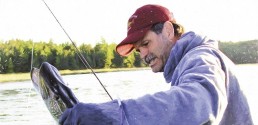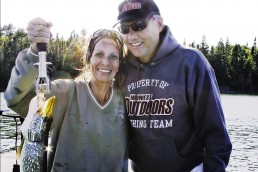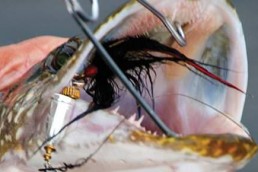How to Catch Fish on your Canadian, Vacation Part 2
Let’s pick up where we left off in the December Canada Fever and keep building our plan for how you are going to catch lots of fish on your Canadian vacation. We are assuming you love fishing, but do not consider yourself an expert, and you wonder why you catch fish some days and struggle other days. We also assume that you are likely to be with family and/or friends, and that you’ll make time to just hang out, go into town, play cards, watch wildlife, etc.
In other words, you aren’t going to fish all day, every day, but you want to make your fishing time count.
Last time, we talked about why it’s important to look at how clear the water is, how water clarity is probably the most important of all variables, and how it can help you decide what time of day to focus your fishing efforts.
We also talked about how to find what remains an under-fished hotspot on most Canadian lakes: mid-depth flats. How you can catch lots of fish if you get away from obvious shoreline spots that you, and everybody else, can see with your own two eyes.
Also, we talked about the importance of weeds and other types of cover, when it comes to locating numbers of fish. And finally, we presented a simple plan for making the most of your fishing time by paying attention to the weather.
We’re off to a good start, but let’s keep it going … Should I cast or should I troll?
What a great question. The answer is “do both,” based on several considerations.
When you head out onto a new lake for the first time, good old-fashioned front trolling is an efficient way to find biting fish. In my mind, I will forever see pages of old Fishing Facts magazines and remember the urgings of Carl Malz that we should spend the first day, or two days, of each trip trolling. He presented it as the fastest way to get to know the lake and find spots that are currently holding fish.
Even with all the newfangled gadgets and refined ideas about fishing, it remains great advice to this day. The latest depth finders and GPS units let you be more precise than ever, improving efficiency to an all-time high.
Here’s a shortcut that will help you know where to troll: Look for spots that do not have endless twists and turns. Your contour-map-reading skills come into play, because you’re looking for straightaways along shoreline drop-offs. In the real world, there is no such thing as a true straightaway, because natural features of the lake bottom contain inside and outside turns. But you’re looking for spots where you could troll down a shoreline drop-off, or the edge of a large mid-lake drop-off, without having to constantly turn in order to stay in the same depth. 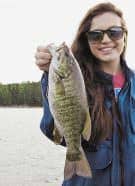
As for depth, here is what you do …
Find out whether there is good weed growth along these spots. If there are good weeds, find out what depth they stop growing. This is known as the deep weedline, one of the most important fish-holding depths in any lake with a decent amount of weeds. This depth can, and does, change during the open-water period, and can change quite a bit from year to year. The most accurate way to determine the depth of the deep weed line is to find such a drop-off, along which weeds are growing, then drive “in and out” from shallow to deep, watching your depth finder carefully. Weeds show up clearly on a depth finder (sonar) display, and you can easily see when they stop showing up. As you drive in and out, make mental note of the depth every time you “run out of weeds” and the display clears up.
Once you have a clear idea of the depth of the deep weed line, that depth should remain consistent in all sections of the lake where the water clarity remains the same. So, now, how do you take advantage of this in your fishing?
Starting with your trolling. Now that you know the depth at which the weeds stop growing, make a plan to troll down a relative straightaway, with your lures running just outside the edge of the deep weed line.
Let’s say the weeds top growing in 12 feet of water. Choose a lure that will run down to about 8 or 10 feet, and troll that thing down the spot, steering as necessary to keep your boat in 14 to 16 feet of water.
Experiment with lures that will actually tick along the bottom, too; this can be extremely important. Fishing legend Larry Dahlberg has a saying that guides his own trolling efforts: “If I’m not tickin’ (bottom), I’m not fishin’.” Because we are not trying to be world champion anglers, and because you might need some practice before you can get super-accurate while following contours, we’re saying it’s okay to run lures above bottom. It’s also true that actively-feeding fish tend to rise off bottom; we’ll try to keep you trolling as long as possible without fouling your hooks with weeds or getting hung up on bottom. You’ll still catch plenty of fish.
Another important tip: also make note of how high the weed tops are! In many cases, weeds might grow out to, say 12 or 14 feet and they will “top out” a few feet from the surface. You can see a gap between the weed tops and the surface by closely studying your depth finder display.
If you have some room between the tops of the weeds and the surface, it can be extremely effective to troll shallow-running baits in that open zone “up high,” and a lot of fish will rise out of the weeds to smash a lure as it comes by. Once you know this depth, it also becomes prime territory to cast shallow-running lures, especially spinnerbaits (because of their natural ability to avoid catching on weeds) on large mid-depth flats.
Anyway, back to the trolling plan: look at your map, find a number of such spots, experiment with lures that run in various depths, experiment by trolling in various depths, and make what they call a “milk run” over your best spots as you begin to catch fish.
You will catch a variety of species doing this, and your catch will usually be dominated by whatever species are most abundant in the lake. Sounds like common sense, and it is.
Focus on the best spots
After you spend some time trolling potentially good spots, you will make some catches, and where you make the catches should become the focus of methodical effort to make more catches.
If you have a GPS unit, press the button to save spots where you catch more than one fish, so you can return to them easily. If you don’t have a GPS, you can triangulate your way back to the spots. To do this, position your boat over a spot, then find two things that line up, such as something on the shoreline and something behind it, in the distance—like a big rock and a particularly tall tree. Write notes if you won’t remember your marks.
While still on the spot, look to the left or right and find one more thing to line up. Examples are endless, such as “where the edges of two islands line up.” Upon your return to this location, you can quickly line up your markers and be right back on the spot. (This is how we had to do it in the old days, and that’s why we love GPS units so much.)
There can be a lot of reasons that a certain stretch of shoreline drop-off, or a certain section of a mid-lake flat, is currently holding more fish than surrounding areas. Without getting too much into figuring out why, when you’re on a week’s vacation, it can be enough to simply find some of these spots.
Trolling, because it helps you cover a lot of territory quickly, reduces the amount of time it takes to find a few good spots. Once you have a few “pins in the map,” you can slide back into those locations and fish in any number of ways. (Don’t forget water clarity; the clearer the water, the farther away you should stay from where you think the fish are. Clear water demands longer casts, and generally you will be more successful when you let out a lot of line while trolling.)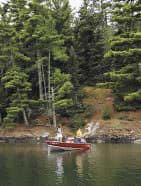
Make a plan to go back to your best spots and either cast or jig, depending on depth, and see whether you can make some good catches by hanging in that specific area longer than you can when you troll by. It’s good to know that, in some cases, there’s something magical about trolling by. For whatever reason, sometimes casting to a spot proves relatively fruitless. Then when you start trolling through the same spot, fish start biting again.
When you approach a spot to do some casting or jigging, slow the boat well out from where you want to fish, and really putt-putt your way in. If you roar in and create a big wake with your boat, it has a way of “putting the fish down,” at least many fish, at least for a while.
Presentation keys
To watch a good angler in action, it can look like a magic act. He or she seems to catch more fish than other people in the boat, day after day, and it can leave you scratching your head.
Here’s what they’re doing: paying attention to presentation details, and making their bait scream “attack me!” unless the fish react better to something else.
You’ve probably heard some form of this idea, but it’s true that predator fish, on most days, tend to spring into action when the right opportunity comes along. That fish might not be up and cruising, looking for something to eat, but if an easy meal comes limping along, instinct takes over and the big fish takes the bait, often without hesitation.
Our whole goal is to get fish to take the bait, right? When you are lucky enough to be casting or trolling in the vicinity of fish primed to eat, it hardly matters what you are doing with your lure. They are likely to eat it no matter how “boring” your presentation is.
But most of the time, you are presenting a lure in places where other potential prey items are swimming and dancing around, and the fish are not passionately pursuing anything. Your bait has to make an impression on fish, in order to inspire them to try to eat it.
So here’s what you do: Make your bait appear to be struggling to maintain balance, struggling to even make it back to the boat. Even when you can’t see your bait, and can’t see a fish following it, make your bait appear to panic and try to get away, using its last ounce of strength. And change speeds. Offer your presentation at a fast pace for a while, then a slow pace, then somewhere in the middle.
Twitches and pulls of the rod will create erratic surges, and pauses will help sell the impression that your lure is not doing well. Twitch-pause, twitch-pause, twitch-twitch-twitch-pause, burn the lure forward for a bit, then stop it completely.
On most days, some combination of “triggering moves,” as they are called, will tend to result in the most strikes. Here’s what’s really important: Every time a fish strikes your lure, recall what you were doing that brought the strike. Then do more of that, and see if you continue to catch fish.
Then, even when you are on a roll, continue to experiment, because you never know what the fish want for sure. You have to keep asking, by showing them things and paying attention to how they react.
In almost every fishing boat, there is one person who doesn’t want to do this. He or she just wants to cast out and reel in steady, because they’re just out there to get some sun and if they catch a fish that’s a bonus. If that person suddenly gets hot, start fishing your bait exactly how they are. Even if you don’t have this person in your boat, experiment with just retrieving at a steady pace, to see if the fish like it.
Try slow, fast and in between. You can do this when trolling, by manipulating boat speed, pumping the rod, turning and going with the waves. Doing any of these things causes surges and pauses of the lures. (Turning causes the outside lures to speed up, and the inside lures to slow down.)
Paying attention to presentation details, you can think your way to more fish than you usually catch. It’s fun, and it keeps your mind engaged as you figure out what the fish want that day.
There’s more, so let’s plan to meet again, in the February Canada Fever section.
Note: this is part two of a three-part series on how average anglers can catch lots of fish on their Canadian vacations. To start planning an adventure, check out northwestontario.com, or call 800-665-7567. There is so much water to explore north of the border, and here’s to your best Canadian summer ever.
MWO
SHARE THIS POST
Did you enjoy this post?
You can be among the first to get the latest info on where to go, what to use and how to use it!
Mark Strand
MidWest Outdoors editorial director Mark Strand is a graduate of University of Minnesota School of Journalism with a minor in Fisheries & Wildlife Science. He has written for nearly every outdoor magazine over the past 41 years, and has written or co-written 14 books. In addition to writing and photography, Strand produces the MidWest Outdoors Podcast, and contributes to MWO digital properties. He is an outdoor generalist who loves hunting and fishing of all types. In 2018 Strand was elected to the Minnesota Fishing Hall of Fame.
